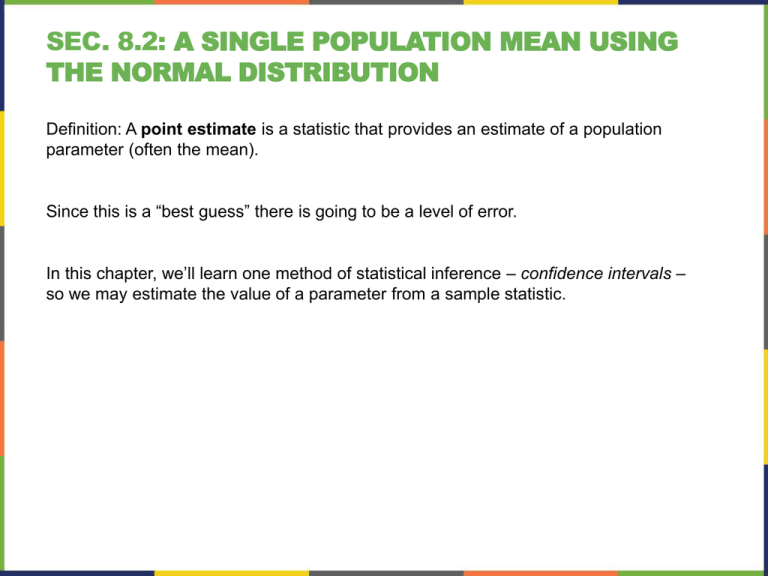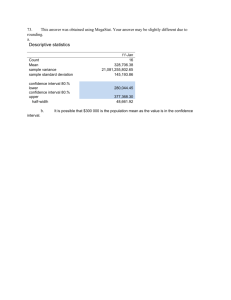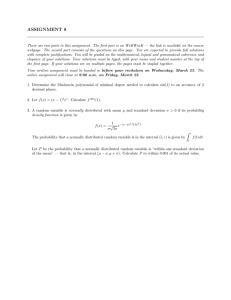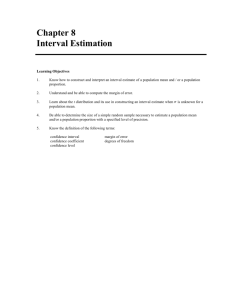
SEC. 8.2: A SINGLE POPULATION MEAN USING
THE NORMAL DISTRIBUTION
Definition: A point estimate is a statistic that provides an estimate of a population
parameter (often the mean).
Since this is a “best guess” there is going to be a level of error.
In this chapter, we’ll learn one method of statistical inference – confidence intervals –
so we may estimate the value of a parameter from a sample statistic.
THE IDEA OF A CONFIDENCE INTERVAL
The big idea : The sampling distribution of x tells us how close to the
sample mean x is likely to be. All confidence intervals we construct will
have a form similar to this :
Sample mean ( 𝒙) ± error bound (EBM)
To get a 90% confidence interval, we must include the central 90% of the probability of
the normal distribution. If we include the central 90%, we leave out a total of α = 10% in
both tails, or 5% in each tail, of the normal distribution.
The confidence level is the overall capture rate if the method is used many times. The sample mean
will vary from sample to sample, but when we use the method estimate ± margin of error to get an
interval based on each sample, 95% of these intervals capture the unknown population mean µ.
𝛼 is the probability that the confidence interval does NOT contain 𝜇.
C.L. + 𝛼 = 1
INTERPRETING CONFIDENCE LEVEL AND
CONFIDENCE INTERVALS
Confidence level: To say that we are 95% confident is shorthand for
“95% of all possible samples of a given size from this population will
result in an interval that captures the unknown parameter.”
Confidence interval: To interpret a C% confidence interval for an
unknown parameter, say, “We are C% confident that the interval from
_____ to _____ captures the actual value of the [population
parameter in context].”
90% AND 95% CONFIDENCE LEVELS
Which would have a smaller confidence interval? Why?
How would we find the bounds of the shaded region?
Find percentiles. For 90% confidence, the bounds are the 5th percentile and 95th
percentile. For 95% confidence, the bounds are the 2.5th percentile and the 97.5th
percentile.
EXAMPLE
Administrators at a school want to construct a 90% confidence
interval for the length of time students on homework per week. It is
known that the standard deviation for all high school students is 17
minutes. The school surveys 100 students at random and finds that
they spend, on average, 154 minutes per week.
a) Define 𝑥, 𝜎, 𝑛.
b) In words, define X and 𝑋.
c) Sketch the graph of a 90% confidence interval and find the
bounds.
d) Find the error bound from the mean EBM (how far each end is
from the mean).
e) Interpret the meaning of the confidence interval.
CALCULATING USING YOUR CALCULATOR
When we know the population standard deviation, we can use a calculator to find the
confidence interval.
Go to STAT, scroll over to TESTS
Choose 7:ZINTERVAL
If we know the mean, highlight Stats and enter 𝜎, 𝑥, 𝑛 and the desired confidence level.
ANOTHER EXAMPLE
The standard deviation of systolic blood pressure is known to be 9.3.
A sample of 50 people is taken and it is found that their average blood
pressure was 114.9 with a standard deviation of 8.
a) Define 𝑥, 𝜎, 𝑛.
b) In words, define X and 𝑋.
c) Sketch the graph of a 95% confidence interval and find the
confidence interval.
d) Find the error bound from mean EBM (how far each end is from
the mean).
PRACTICE
Delays for a train are known to have a standard deviation of 3
minutes. 40 trains are randomly sampled for how long they were
delayed. It was found that the sample mean delay was 12 minutes
with a standard deviation of 2.5 minutes.
a) Define 𝑥, 𝜎, 𝑛.
b) In words, define X and 𝑋.
c) Sketch the graph of a 90% confidence interval and find the
confidence interval.
d) Sketch the graph of a 95% confidence interval and find the
confidence interval.
e) How are the two confidence intervals different? Which is larger?
Why?
THE STANDARD NORMAL DISTRIBUTION (ZDISTRIBUTION)
This is the same as the normal distribution we have seen before, but
has a mean of 0 and standard deviation of 1, so the z-score matches
with the x-value.
ERROR BOUND FORMULA
The error bound formula for the population mean 𝜇 when the
population standard deviation 𝜎 is known is:
Where n is the sample size and 𝑧𝛼 is the z-score with the property that
2
𝛼
2
the area to the right of the z-score is .
What if we know what error bound we want, but not how many things
we need to sample?
FINDING A SAMPLE SIZE FOR A PARTICULAR
CONFIDENCE LEVEL
Use:
Where z is the same as 𝑧𝛼 .
2
Example:
High school students who take the SAT Math exam a second time
generally score higher than on their first try. Past data suggest that the
score increase has a standard deviation of about 50 points. How large
a sample of students would be needed to estimate the mean change
in SAT score to within 2 points with 95% confidence?
PROPERTIES OF CONFIDENCE INTERVALS:
The user chooses the confidence level, and the error bound follows from this
choice.
The error bound depends on the confidence level and the sampling
distribution of the statistic.
Greater confidence requires a larger error bound
The standard deviation of the statistic depends on the sample size n
The margin of error gets smaller when:
The confidence level decreases
The sample size n increases
SEC. 8.3: A SINGLE POPULATION MEAN USING THE
STUDENT T DISTRIBUTION
We talked yesterday of using the Z-distribution (normal) to find
confidence interval. To use this, we need to know the population
standard deviation or have a large sample size (30 or more) so the
sample standard deviation approximates the population standard
deviation.
What if we don’t have this???
THE STUDENT T-DISTRIBUTION
If we have a roughly normal distribution, but don’t know 𝜎, we can use the student tdistribution to calculate confidence intervals.
The shape of the curve, depends on n; the larger n, the closer it is to the normal
distribution
DEGREES OF FREEDOM
When using the student t-distribution, we use the degrees of freedom, n-1, to
characterize the shape.
EXAMPLE:
A study of commuting times reports the travel times to work of a random sample of 20
employed adults in New York State. The mean is 31.25 minutes and the standard
deviation is 21.88 minutes.
a) 𝑥= __________
sx = __________
n = __________
n – 1 = __________
b) Define the random variables X and 𝑋 in words.
c) Which distribution should you use for this problem?
d) Construct a 95% confidence interval for the population mean. State the confidence
interval.
e) Sketch the graph.
f) Calculate the error bound.
g) Explain in a complete sentence what the confidence interval means.
ANOTHER EXAMPLE (FUEL EFFICIENCY)
Computers on cars track their fuel efficiency, or miles per gallon(mpg). Following
are the mpg values for 20 different cars.
15.8 13.6 19.1 22.4 15.6 22.5 17.2 19.4 22.6 15.6
19.4 18.0 14.6 19.7 21.0 14.8 22.6 21.5 14.3 20.9
a) 𝑥= ______
sx = _____
n = ______
n – 1 = ______
b) Define the random variables X and 𝑋 in words.
c) Which distribution should you use for this problem?
d) Construct a 95% confidence interval for the population mean. State the
confidence interval.
e) Sketch the graph.
f) Calculate the error bound.
g) Explain in a complete sentence what the confidence interval means.
PRACTICE
The body temperature of 130 patients is recorded and the mean of the
sample is 98.429 with a standard deviation of 0.733.
a) 𝑥= __________
sx = __________
n = __________
n – 1 = __________
b) Define the random variables X and 𝑋 in words.
c) Which distribution should you use for this problem?
d) Construct a 98% confidence interval for the population mean. State the
confidence interval.
e) Sketch the graph.
f) Calculate the error bound.
g) Explain in a complete sentence what the confidence interval means.
SEC. 8.4: A POPULATION PROPORTION
During an election year, we see articles in the newspaper that state
confidence intervals in terms of proportions or percentages.
The procedure to find the confidence interval, the sample size, the
error bound, and the confidence level for a proportion is similar to that
for the population mean, but the formulas are different.
HOW DO YOU KNOW YOU ARE DEALING WITH A
PROPORTION PROBLEM? THE UNDERLYING
DISTRIBUTION IS A BINOMIAL DISTRIBUTION.
If X is a binomial random variable, then X ~ B(n, p) where n is the
number of trials and p is the probability of a success.
To form a proportion, take X, the random variable for the number of
successes and divide it by n, the number of trials (or the sample size).
𝑋
The random variable P′ (read "P prime") is that proportion, P′= .
𝑛
p′ =
𝑥
𝑛
p′ = the estimated proportion of successes (p′ is a point estimate
for p, the true proportion.)
x = the number of successes
n = the size of the sample
USING YOUR CALCULATOR
In the STATS menu under tests, is the option 1-Prop-Zinterval, which
uses the normal distribution to estimate the confidence interval given
sample data.
Enter x = number of successes (make sure it is a whole number)
n = number of trials
C-Level = desired confidence level
EXAMPLE: VOTERS
A random poll of 600 registered voters asked how many had voted in
the last election. 330 responded that they had voted. Using a 95%
confidence level, compute a confidence interval estimate for the true
proportion of people who voted in the last election and find the error
bound.
X = 330
n = 600
C-level = 0.95
Confidence interval = (0.51, 0.59)
𝑝 = 0.55 (represents the point estimate)
Error bound = 0.59 – 0.55 = 0.04
EXAMPLE: OWNING CARS
A poll of city residents finds that 87% of those asked own a car. The
poll asked 990 residents. Create a 90% confidence interval for the
true percentage of residents that own cars and find the error bound.
ESTIMATING THE SAMPLE SIZE NEEDED
The formula:
provides the number of participants needed to estimate the population
proportion with confidence 1 - α and margin of error EBP.
Example: How many people should be sampled to determine within
2% the true proportion of voters who will vote for a particular
candidate in the election with 95% confidence?
This PowerPoint file is copyright 2011-2015, Rice University. All
Rights Reserved.




